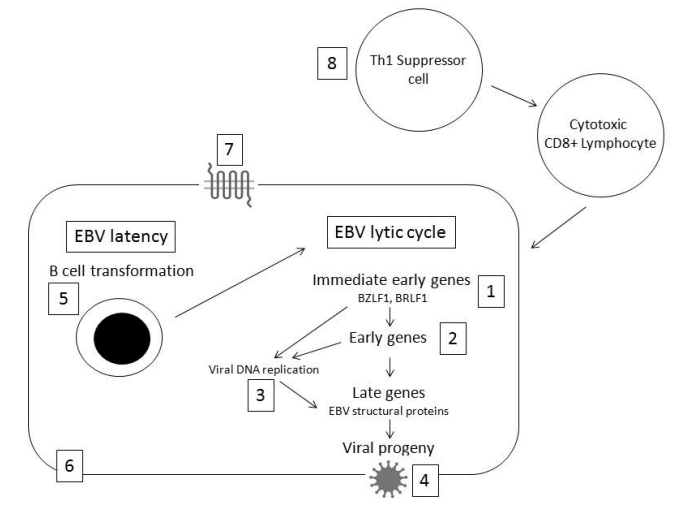Skin and Cancer
The skin is one of our largest organs, serving as a physical and metabolic barrier, our front line against the influence of our physical and chemical environment, and our first line of defense against invading pathogenic microorganisms. The skin has a unique ecosystem of bacteria, fungi, and viruses that together make up the skin microbiome. As a community with complex interactions, this microbiota relies heavily on the few nutrients it can obtain from the stratum corneum (SC) as well as from sebaceous, exocrine, and apocrine secretions. However, since the skin is a chronically nutrient-poor environment, microbial symbionts have to rely on the use of external carbon and energy in the form of xenobiotics. In addition, some immune system diseases usually involve the skin, causing skin dysfunction. Visual analysis and localization of genes of interest in the skin are of great importance for improving related diseases.
 Fig 1.Schematic diagram showing Epstein-Barr virus (EBV) latency with B-cell transformation. (Jonathan R Kerr, et al. 2019)
Fig 1.Schematic diagram showing Epstein-Barr virus (EBV) latency with B-cell transformation. (Jonathan R Kerr, et al. 2019)
Visual Analysis Services on Skin Samples
Our platform provides in situ visualization analysis solutions for skin samples, helping researchers locate genes of interest in skin samples. Our analysis services can be performed on mouse models of immunodeficiency syndromes, which involve major immune disorders of the skin, and our FISH hybridization services can be used for immune cell typing and localization analysis. In addition, the service can analyze polyoma and Epstein-Barr virus (EBV) in cancer. EBV belongs to type IV of the human herpesvirus family and is a double-stranded DNA virus with a high affinity for B lymphocytes. It is ubiquitous in nature, and humans are its only host. Polyomaviruses (JCV, BKV, and SV40) have been detected in a variety of cancers and can be involved in the occurrence and development of cancers as cofactors in malignant transformation and tumor progression. This service aims to develop more FISH applications related to expression analysis in the skin with the analysis of skin samples as the core. You are welcome to explore more discoveries with us.
Applications
EBV is involved in the pathogenesis of cancer mainly through its LMP-1, LMP-2A, EBNA1, and BARF1 oncogenes. Our FISH analysis solutions are available for in situ analysis of EBV and EBV early transcripts (EBER) of samples;
Our experimental platform enables co-expression analysis of transcripts and proteins, such as detection of EBV early transcript (EBER) and LMP-1 protein in head and neck cancer samples by in situ hybridization (ISH) and immunohistochemistry (IHC);
We also offer protocols for the analysis of polyomaviruses (JCV, BKV, and SV40) in cancer samples;
We also provide services for the analysis of immune cell types in samples;
Creative Bioarray offers a diverse range of FISH testing services for the expression analysis of viral genes in skin samples from viral infections or in cancer. Our FISH applications are developing more and more possibilities, and with our extensive experience in testing services, we are confident to provide you with a competitive solution. If you are interested in our service, please contact us for cooperation. We look forward to cooperating with you in the near future.
Reference
- Kerr, Jonathan R. "Epstein-Barr virus (EBV) reactivation and therapeutic inhibitors." Journal of Clinical Pathology 72.10 (2019): 651-658.


 Fig 1.Schematic diagram showing Epstein-Barr virus (EBV) latency with B-cell transformation. (Jonathan R Kerr, et al. 2019)
Fig 1.Schematic diagram showing Epstein-Barr virus (EBV) latency with B-cell transformation. (Jonathan R Kerr, et al. 2019)


